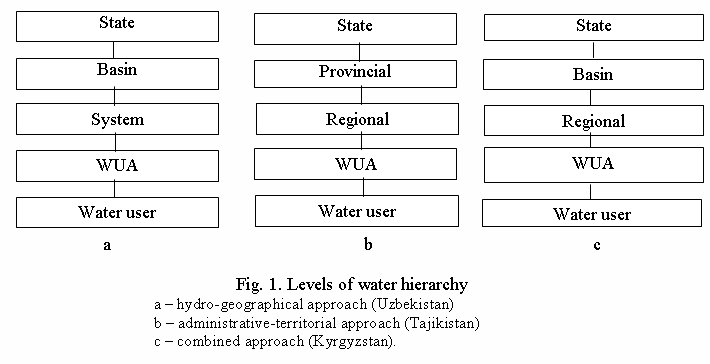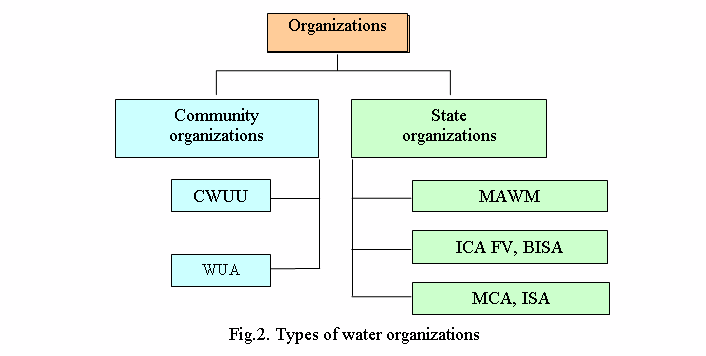
To the beginning of the section
Organizations
Institutional measures coordinate activities of people on the way of achieving objectives set before the society, particularly, to ensure more desirable water use. Broad institutional measures aimed at water saving (ownership rights, pricing policy, …) are expedient only in places, where water is rare and highly valued.
Organizations can be in form of hierarchies (public or private bureaucratic structures) or voluntary associations. They exist in water supply systems on both the demand side (users) and the supply side (allocation).
Usually, on the supply side, we find the public bureaucratic structures, such as ministries, basin water organizations (BWO), provincial and district water management organizations, inter-district canal administrations, etc. that control diversion, storage, delivery and distribution of water from irrigation sources. Those structures, as a rule, does not always accountable before water users for quantity and quality of water delivered.
Under centralized approach to water management, organizations on the supply side are usually established according to the administrative principle. In opposite, decentralized method is characterized by hydro-geographical approach, which ignores administrative boundaries.
Under centralized method of water management, water organizations lack divisions that could implement the public participation principle. Therefore, it is necessary to establish and incorporate into the water sector the bodies of joint water governance, i.e. participatory water governance.
At present, attempts are made in water sector practices to overcome that shortcoming; however, it is implemented in such a way that those attempts fail or their effect is very weak.
Particularly, organizations of water users were established at lower level of water management. It is well-known that the most popular form of such organizations in CAR is the Water User Association* (WUA). It is believed that the main advantages of WUA, as compared to public organizations, are: more effective and reliable water delivery; operative settlement of water-related conflicts; lessening of state’s financial load; and others. However, in practice, most WUAs are still institutionally and financially non-viable.
* For non-market economies, particularly, for former Soviet republics, the chief hydraulic engineer service of former collective or state farms served as a demand-side entity.
Attempts are made to form Basin councils (commissions) at the upper levels of water hierarchy. However, stakeholders are involved to a limited extent in activities of those organizations. As to demand-side organization, this matter has not been addressed either.
The analysis of water entities shows that usually these are legal ones, i.e. organizations. However, legal entities can be formed as non-legal ones as well. Those include Water-Management Councils, Water Commissions, Water Committees, WUAs Councils, etc.
Water entities are formed in linkage with different levels of the water hierarchy. The levels of water hierarchy are classified depending on an approach used for formation of water entities. Figure 1 shows hierarchical levels for: a - hydro-geographical approach, b – administrative-territorial approach, and, c – combined approach.

Practices and analysis show that water management quality to a larger degree depends on relevancy of assigned functions to the form of water organization. Figure 2 shows types of water organizations. Two types of organizations exist at state level in the project area. Those are community and public organizations*.
* World practices also show private water organizations. At transboundary river level, the interstate water organizations, e.g. ICWC are formed as well
During the Soviet period, both state (state farm) and community (collective farm) entities functioned at the lower level of water distribution. After reforms in CAR, one form (collective farm) of community organizations was replaced by another one (WUA). By present, other forms of community water organizations have formed as well: water user unions, canal water user unions.

Along with state and community organizations, other water entities occurred as part of the IWRM-Fergana Project: groupings of water users in form of Canal (System) Water Users’ Unions (CWUU), and join water governance bodies in form of Main Canal Water Committees (CWC). Those were established along four main canals: South Fergana main canal (Uzbekistan), Aravan-Akbura canal, Right-bank main canal (Kyrgyzstan), and Khoja-Bakingan canal (Tajikistan).
All those organizations (bodies) have both strengths and weaknesses. Building capacities of the organizations and better usage of strengths of the water bodies is a very topical issue.
One of key ideas of IWRM is that prospective improvement of water supply and water use is closely linked to public participation at all levels of water hierarchy.
Improvement of management system
There is close connection between organizational and managerial actions, on the one hand, and operational features of irrigation and drainage systems, on the other hand. In a new era of irrigation and water development, performance of water management organization (WMO) will play the key role in water management in order to achieve sustainable agricultural production.
Improvement of WMO’s management system should be based on the following: 1) ultimate aim of management process - making the organization more productive and effective for near and far future; 2) WMO should develop four roles of management:
• (P)roducing results — the first and foremost role of an organization is to produce results. The result to be produced - the basic reason for the existence of the organization.
• (A)dministering — focuses on how to do things to ensure effectiveness.
• (E)ntrepreneuring — drives the organization to successfully adapt to change.
• (I)ntegrating — focuses on the development of a cohesive team that makes the organization efficient over the long term.
For good health WMO needs to have all four roles. Absence of any of the roles threatens by disease – poor management. To ensure better roles, WMO must possess appropriate capacities (institutional, human, engineering).
The management structure of WMO is comprised of three elements:
• Responsibility (duties).
• Empowerment.
• Rewards.
WMO should meet all the above three conditions for effective performance of its staff: a staff-member knows his/her duties, is enough empowered to fulfill his/her duties, and relies on adequate rewards.
The analysis of water management in Uzbekistan shows that WMOs have relatively successful roles of producing (P) and administering (A) that are oriented towards short-term tasks. The other two roles (entrepreneuring (E) and integrating (I)) that are oriented towards mid- and long-term tasks are not so successful due to lack of necessary human and organizational capacities at all levels of hierarchy. Moreover, in the context of centralized water governance inherited from Soviet times, the lower is the hierarchical level, the poorer is available capacity.
Institutional improvement
Establishment of new water entities and improvement of existing ones should be stage-by-stage and follow the principles as listed below:
• Division of functions on water governance and water management (at all levels of water hierarchy).
• Decentralization of water governance and management functions at the national level.
• Delivery of water governance and management functions in a regulatory form at the national level.
• Division of functions on water supply management and water demand (water usage) management (at the levels of irrigation systems and sub-basin). Organization responsible for water supply should not control quality of supply and usage of water.
• It is advisable to establish water supply organizations within hydrographic boundaries.
• It is advisable to establish organizations dealing with usage of water (and land) on the basis of territorial principle.
• Involvement of stakeholders in decision making by their integration.
Author: Mirzaev N.N., SIC ICWC